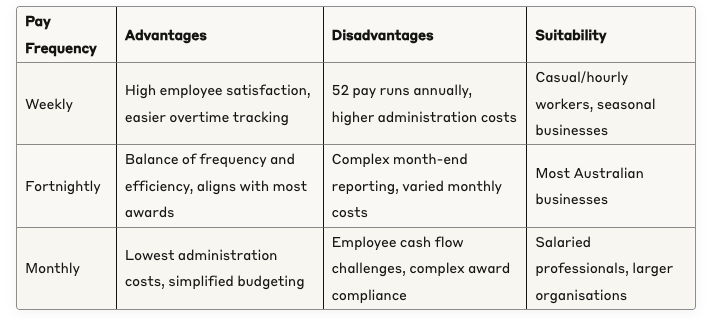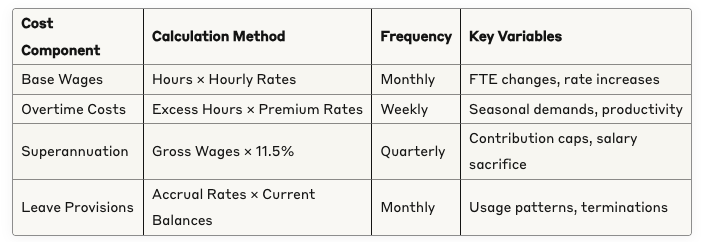
Published: July 2025
Payroll processing represents one of the most critical yet complex operational challenges facing Australian businesses today. With over 13 million employees across the country relying on accurate, timely payments, and the Australian Taxation Office processing more than $500 billion in PAYG withholdings annually, the stakes couldn't be higher for getting payroll right.
The consequences of payroll errors extend far beyond simple inconvenience. Late or incorrect payments can trigger Fair Work investigations, result in substantial penalties, damage employee relationships, and create significant cash flow complications. Research by the Australian Institute of Payroll shows that businesses with inefficient payroll processes spend up to 35% more time on payroll administration than those with optimised systems.
Australian businesses face unique payroll complexities including superannuation guarantee obligations, varying state-based leave entitlements, award interpretation requirements, and increasingly sophisticated regulatory reporting. Modern payroll isn't just about calculating wages—it's about managing compliance, maintaining employee satisfaction, and supporting strategic business decisions through accurate labour cost reporting.
Before exploring efficiency strategies, it's crucial to understand the foundational elements that make Australian payroll particularly complex compared to other jurisdictions.
Australian payroll operates within a comprehensive regulatory environment governed by multiple authorities and legislation:
Each framework carries specific timing requirements, calculation methodologies, and reporting obligations that must be integrated into your payroll process.
Understanding critical payroll deadlines prevents costly penalties and maintains regulatory compliance:
Modern Australian businesses must navigate numerous industrial instruments:
Each instrument contains unique calculation methodologies for ordinary hours, overtime rates, penalty payments, allowances, and leave entitlements that must be accurately reflected in payroll processing. Speak to your bookkeeper if you are unsure.
Creating consistently timely payroll requires systematic approach to process design, technology selection, and workflow optimisation. Your system architecture should balance automation benefits with necessary human oversight and control.
Effective payroll begins with clearly defined processes documented in detail sufficient for consistent execution regardless of staff availability:
Pre-Payroll Phase (Days 1-3 of pay cycle)
Payroll Processing Phase (Days 4-6)
Post-Payroll Phase (Days 7-10)
Modern payroll efficiency depends heavily on appropriate technology selection and configuration. Consider these essential system capabilities:
Core Payroll Engine Requirements
Integration and Data Flow Management
Implement systematic quality control measures preventing errors before they impact employees or compliance:
Pre-Processing Validations
Processing Stage Controls
Post-Processing Verification
Consistent, predictable payroll timing requires careful planning, realistic scheduling, and contingency management. Australian businesses must balance employee expectations with operational requirements and compliance obligations.
Choose pay frequencies aligning with your business operations while minimising administrative burden:

Develop processing schedules accounting for all necessary tasks while building in contingency time for unexpected issues:
Fortnightly Payroll Example Timeline
Week 1:
Week 2:
Australian businesses face predictable payroll challenges during certain periods requiring additional planning and resources:
End of Financial Year Processing
Christmas and Holiday Periods
Leverage technology to reduce manual effort, improve accuracy, and ensure consistent processing regardless of workload variations or staff availability.
Automate timesheet collection and validation through integrated systems:
Modern integrated systems can reduce payroll preparation time by 60-70% while improving accuracy through elimination of manual data entry and transcription errors.
Streamline leave processing through comprehensive automated systems:
Reduce compliance risks through automated monitoring and reporting:
Effective payroll isn't just about timeliness—it's about managing labour costs strategically while maintaining compliance and employee satisfaction.
Implement comprehensive reporting enabling strategic decision-making:
Develop sophisticated forecasting capabilities supporting business planning:

Optimise cash flow through strategic payroll timing and planning:
Australian payroll compliance extends beyond basic calculations to encompass comprehensive record-keeping, reporting accuracy, and proactive risk management.
Maintain comprehensive documentation meeting legal requirements while supporting business operations:
Australian law requires employers to maintain payroll records for seven years, with some records requiring permanent retention. Digital record-keeping systems should include robust backup and security measures protecting sensitive employee information.
Single Touch Payroll reporting requires real-time submission of payroll information to the Australian Taxation Office, fundamentally changing traditional payroll workflows:
Mandatory Reporting Elements
Implementation Strategies
Superannuation obligations represent significant compliance risks requiring systematic management:
As businesses expand, payroll systems must evolve to accommodate increased complexity while maintaining efficiency and accuracy.
Managing payroll across multiple jurisdictions introduces additional complexity requiring systematic management:
Develop scalable processes accommodating business growth without proportional increases in administrative burden:
Transform payroll from administrative function to strategic business tool through comprehensive analytics:
Develop resilient payroll operations capable of maintaining service during disruptions while ensuring employee welfare and compliance continuation.
Create comprehensive plans ensuring payroll continuation during system failures or operational disruptions:
Adapt payroll processes supporting distributed workforces while maintaining accuracy and compliance:
Develop capabilities for rapid response to regulatory changes affecting payroll processing:
Establish metrics and processes supporting ongoing improvement in payroll efficiency, accuracy, and employee satisfaction.
Track meaningful metrics providing insight into payroll effectiveness:
Compare your payroll performance against industry standards and best practices:
Implement systematic approaches to ongoing payroll enhancement:
How far in advance should we start processing payroll?
Begin payroll processing at least 5-7 business days before pay date to accommodate validation, approvals, and potential issues. For fortnightly payroll, start timesheet collection immediately after the previous pay period ends. Weekly payroll requires 3-4 days minimum processing time, while monthly payroll needs 7-10 days due to increased complexity and volume.
What's the most efficient pay frequency for Australian small businesses?
Fortnightly payroll offers the best balance of employee satisfaction and administrative efficiency for most Australian businesses. It aligns with most modern award requirements, provides reasonable cash flow for employees, and requires only 26 pay runs annually compared to 52 weekly runs.
How can we reduce payroll processing time?
Implement automated time capture systems, integrate payroll with other business systems, standardise approval workflows, and use electronic payslip distribution. These measures typically reduce processing time by 50-70% while improving accuracy and compliance.
What are the consequences of late superannuation payments?
Late superannuation payments trigger Superannuation Guarantee Charge (SGC), which includes the shortfall amount, interest charges (currently 10% per annum), and an administration fee of $20 per employee per quarter. The SGC is not tax-deductible, making it significantly more expensive than timely compliance.
Should we outsource payroll or keep it in-house?
The decision depends on business size, complexity, and internal capabilities. Businesses with fewer than 20 employees often benefit from outsourcing, while larger organisations with complex requirements may prefer in-house control. Consider factors including cost, compliance risk, data security, and strategic importance to your operations.
How do we handle payroll during public holidays?
Plan payment schedules accounting for banking closures during public holidays. Process payments 1-2 days earlier when banks are closed, communicate schedule changes to employees in advance, and ensure superannuation and tax payments aren't affected by holiday timing.
What records must we keep for payroll compliance?
Maintain employee records (personal details, contracts, TFN declarations), time and wages records (hours worked, rates paid, allowances), payment records (payslips, bank payment confirmations), and leave records (applications, approvals, balances) for seven years minimum.
How do we ensure payroll accuracy across multiple locations?
Standardise processes and systems across all locations, centralise payroll processing where possible, maintain consistent chart of accounts and coding structures, implement comprehensive quality controls, and provide regular training to ensure uniform application of procedures.
What should we do if we discover a payroll error?
Address errors immediately through correction payments or adjustments, communicate transparently with affected employees, investigate root causes to prevent recurrence, update relevant compliance reports (STP amendments, superannuation adjustments), and document the error and correction process for audit purposes.
How can we prepare for end of financial year payroll requirements?
Start planning 8-10 weeks before year-end, review employee records for accuracy, reconcile leave balances and superannuation contributions, prepare payment summary processes, schedule additional resources for increased workload, and communicate timeline expectations with employees and stakeholders.
Sydney Bookkeeper offers bookkeeping services for Australian SMBs, including payroll management that supports Single Touch Payroll (STP) compliance through payroll calculations, employee onboarding, payslip distribution, and PAYG assistance. Our services also cover ATO compliance with BAS and IAS preparation, GST mapping, and year-end audit support to meet tax and superannuation reporting requirements.
Additional offerings include financial reporting such as profit and loss reviews, balance sheet analysis, monthly cash flow reviews, and margin analysis, along with accounts receivable and payable management for handling invoices and payments. We provide Xero setup, migration, and training to integrate with cloud-based systems. Services can be fully or partially managed, with options for weekly or monthly reconciliations and catch-up for backlogged records, available without lock-in contracts on a pay-for-what-you-use basis. An onboarding process starts with a free assessment and customised proposal. For more details, visit our website at www.sydneybookkeeper.com.
sydney bookkeeper offers expert bookkeeping services sydney-wide for business owners, finance managers, and accounting firms to fuel local business growth.our sydney team delivers affordable packages, including professional bookkeeping, invoicing, payroll, and xero services.
from reconciliations to bas and xero setup, we ensure ato compliance, cut costs, and automate tasks, helping you scale confidently without long term contracts.perfect for businesses throughout sydney seeking reliable, local support.
ready to simplify bookkeeping and focus on growth?
our sydney bookkeeper experts will assess your needs and show how much time and money you can
save with our tailored services. no lock-in contracts.
pay only for what you use and pause anytime.


